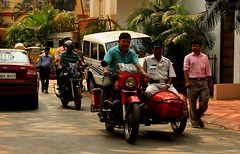
Priests one of many ceremonies for the Goddess Durga
First published on Pickled Politics
Calcutta is in the midst of the Durga Puja – the 10 day carnival celebrating the goddess Durga. It is the annual climax of Calcutta’s cultural ethos.
Not having grown up in Calcutta, I had never actually attended this celebration as a child. So at 30 when I moved to the city, I was fascinated and curious. I photographed the celebrations from every angle and asked a million questions.Hundreds of pandals— elaborate temple like structures of bamboo, cardboard and jute—are are set up all over the city, which house the idols of the goddess and her family. There are different ceremonies marking each of the 10 days with enthralling symbolisms.
Yet, within a couple of years my puja fever had died down, and that was largely because I didn’t appreciate a lot of what I was discovering about the pujas.
So much so, that over the last 5 years, I have consistently boycotted the Pujas and urged others to do the same. Here are my reasons why:
1. Junking the River: At the end of the celebrations all the idols are immersed in the Hoogly – the city’s river, a tributary of the Ganges. There are more than 40,000 idols dumped into the Hoogly every year. These idols are larger than life, some of them 10-20 feet tall, and most are made of non-biodegradable materials like concrete, fiberglass and metal. These don’t wash downstream. They sink to the bottom and make the river bed one big junkyard.
2. Poisoning the river: Most of the paints used on the idols are toxic and also carcinogenic (cancer causing). And because the junk sits at the bottom of the river, it just keeps leaching this poison into the waters.
3. Poisoning the City’s Water supply: This poisoned water of the river Hooghly is the water supply for the city of Calcutta .
4. Poisoning the food: The people of Calcutta don’t just drink this poisoned water, but they are a fish eating community and they eat fresh water fish from this river, fish that have also imbibed this poison.
5. Increasing rates of Cancer: The rates of various types of cancer in Calcutta and Bengal have been increasing steeply.
6. Extinction of wildlife species: The Gangetic River Dolphin, which is evolutionarily blind and navigates by echo-location (a hard task for sure with all the junk in the river) is almost on the brink of extinction because of this kind of dumping on and poising of the river.
7. Perpetuate Ignorance and Myths: The myth bought by many Indians, is that the river Ganges is so powerful that it can take all the rubbish that people dump into it and effectively cleanse itself. That is not true! The river needs proper management and care and citizens must act responsibly.
8. Perpetuates the use of the river as city’s garbage dump: The river is not a garbage dump and the only solution is to stop all immersions as soon as possible.
9. Perpetuates Mindless and Destructive Traditions The tradition of idol immersions is recent and man-made. Earlier Durga idols showing the goddess spearing the demon, as displayed at the Indian Museum, are in bronze, with the clothes and accessories sculpted on. These were certainly not for immersion. Calcuttans must put their heads together and come up with an alternative way of symbolizing the ‘leaving’ of the goddess, without actually junking the idols, a method which is environmentally sustainable and not harmful to community health. Traditions change and it is time for this one to. Why not – if we can have pujas offered on the internet!
10. Waste of Millions of Dollars Needed Elsewhere: The cost of the puja is estimated at over a billion rupees, all collected through donations from citizens and private companies!! But is a self-destructive and wasteful spending of money. Calcutta obviously has the means to mobilize grassroots funds on a massive scale as proven by the chanda (puja donations) collected. So I would also want to see puja committees using at least 80% of the chanda collected for long-term projects that will serve the community – like schools, clinics, shelters for women, and parks.
The river is not a garbage dump. It is a source of life and living for humans and all other plant and animal life forms. Th only solution is to stop all idol immersions in the river as soon as possible.

Hundreds of pandals (temporary temples) like this are built all over the city. They are elaborate and take more than a month to erect. And they block lanes and neighborhoods!










![earth-day-and-kids1[2]](https://ritabanerjisblog.files.wordpress.com/2011/11/earth-day-and-kids12.jpg?w=600)








